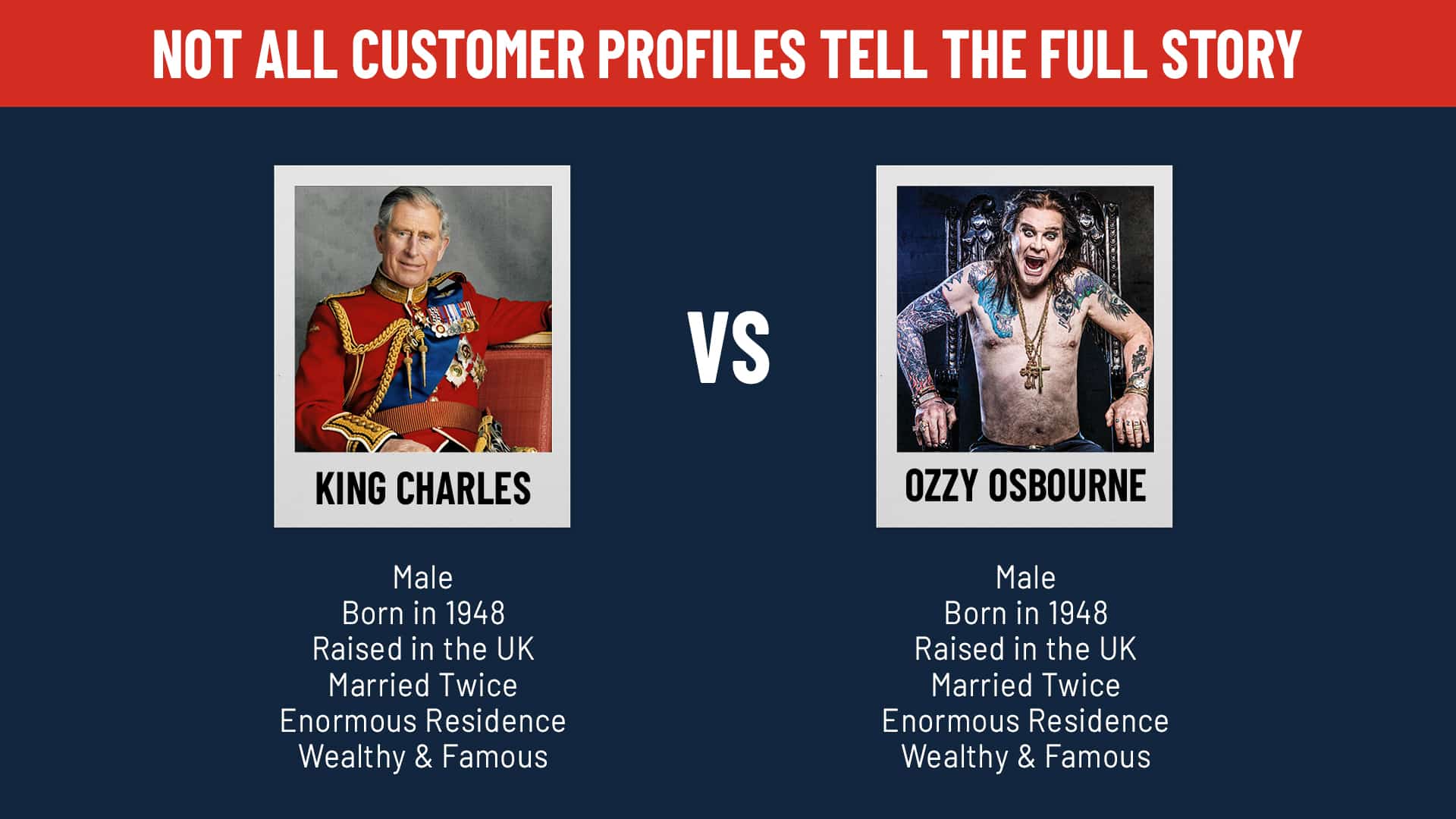Understanding customer profiles is knowing Ozzy may be daydreaming about his next colourful tattoo, while Charles may be contemplating his newest pair of doeskin riding boots.
My point is, if you only understand your customers at the superficial level, you’re not going to be able to get inside their head, understand what value you can bring to them, and most importantly, how to sell to them.
Begin to understand customer profiles.
Understanding the core attributes of your ideal target begins very simply – it’s Marketing 101. This is the basic stuff that every marketer does – name, rank, serial number. It’s the Ozzy and Charles conundrum: we’re looking for 70-year-old males who were brought up in England, and who are very wealthy. OK, that’s great – that’s who we sell to – right?
But stopping there will result in a lot of misfires. To get maximum value from your marketing bang, you need to behave like a sniper, rather than a machinegun.
It starts with an analysis of your existing top customers and the features they have in common. What makes them ideal? For example:
- Are they easy to work with and satisfy?
- Are they profitable to service?
- Do they pay on time?
You need to go several layers deeper.

Why did they choose you? By understanding that, you will know why someone else would choose you, and the thinking process they will go through to get there.
As a marketer, salesperson or business owner, you need to understand more about what triggers the purchase of tech. Is it a funding event or is it a management change? Is it because of some new legislation? Or is it because of unforeseen market factors? Take the COVID pandemic as an example.
Nobody was overly enthusiastic about buying a video conferencing service – and then COVID happened!
This Harvard Business Review article on implementing new tech gives some of the factors you may want to consider when preparing sales and marketing content.
If you’ve got time, discover even more about factors impacting the buyer’s journey in this Gartner e-book – it contains a wealth of insights.
Consider who you beat to get the business? And why?
Ozzy and Charles are probably not out there actively researching their purchases – they’ve got people to do that for them!
This illustrates why you need to think about your perfect target customer. If you’re only selling to the CEO and speaking their language – the things they most care about are reputation, market-share and the profitability of the business. These are very different things to what matters to the CTO – they mostly care about innovation, keeping the lights on, and business as usual. If it’s the Finance Manager, they primarily care about getting more from less.
But all three of them might be involved in the decision to choose a Tech supplier, so if all your communication only talks to market-share and reputation then you’re in trouble. You need to know about all the people who are likely to be involved in the sales process and address their primary motivators.
Sales is a relay race…
This analogy is mission critical. What are the legs of the relay your team will have to win? Identify all the people that you might deal with, identify the roles and goals of both the handbrakes and the power sponsors, and make sure your content speaks to all of them. What makes them tick?

If you’re selling to businesses in the construction industry, then you need to understand more about them. What are they dealing with at the moment? For example, one of the fallouts from the COVID pandemic is a huge shortage of materials, while at the same time, in new housing there’s more work than the industry can handle.
The takeaway here is that builders may want to look at marketing their services to a different market such as renovations, extensions, commercial, building repairs or maintenance contracts.
Take a deeper dive and know more…
To identify prospects, you will start with analysing the basics of what they have in common with your existing client-base:
- Vertical
- Size
- Location
- Complexity
To go deeper pick up the phone and speak with your existing clients.
- Do you know what were the problems they were trying to solve?
- What is their ownership structure – or how many layers will be in the decision-making cake?
- What events triggered their need?
- Why did they choose you?
- What value have you delivered?
- What are they saying about you?
You’ve probably gathered that I love a metaphor, like this one about two Woodsmen.
Both started and finished at the same time each day, but one of them always cut more trees. Plus, he always had time to disappear for one hour each day for his Lunch Break while the other kept working.
One day he was asked: “You disappear for an hour each day, and yet you chop more trees that I do. How can that be?”
His reply: “Yeah, I’m off sharpening my axe.”
What’s my point?
Well, December-January is the time you should be sharpening your axe. The time to have a conversation with your customers. Time to understand what value they’ve derived from working with you.
If they say nice things, sure, it’s a validation of your business model and a nice boost. But the insights may really surprise you. You may think you sold them a software program, but what they actually received is more time off, greater business insights, and better visibility for their business.

I had such instance a few weeks ago in a one-on-one coaching session with one of my Sales Accelerator Masterclass participants, who I had urged to phone some of his customers.
He had very definite ideas on why a long-term NGO customer chose his business. Turns out what he thought, and the real reason were two completely different things. He thought the decision was based on a great referral and his competitive pricing model.
Why they actually choose his company is because he was constantly talking his contact through holes he could see in the tender process. He educated her to understand the shortcomings and pitfalls he had identified – what it didn’t cover, and how they could find themselves in trouble if things weren’t clarified with the successful tenderer.
So, in the end it wasn’t about price or referrals. It was because other tenderers just wanted to push their agenda, while he was establishing an environment of trust and confidence based on pointing out the potential ”gotcha’s”.
The lessons here?
- Unless your target customer is every middle-aged Brit who lives in a castle, dive deeper into their uniqueness so you can finetune your targeting and your pitch.
- DO NOT assume you understand why your customers chose you, and then choose to stay with you. Pick up the phone and find out!






